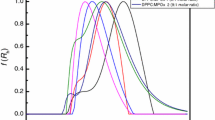Abstract
Purpose. The purpose of this study was to investigate polyethyleneglycol(PEG)-phosphatidylethanolamine(PE) conjugate interaction with phospholipid bilayers, in an attempt to explain the dependence of liposome circulation time on formulation.
Methods. Differential scanning calorimetry, electron microscopy, dynamic light scattering and NMR were the major methods used in the study.
Results. Mixtures of PEG-phospholipid conjugates and phosphatidylcholine existed in three different physical states: a lamellar phase with components exhibiting some miscibility, a lamellar phase with components phase separated, and mixed micelles. Beyond 7 mol% of PEG(l,000–3,000)-dipalmitoyl phosphatidylethanolamine (DPPE), and 11 mol% PEG(5,000)-DPPE in dipalmitoyl phosphatidylcholine (DPPC), a strong tendency towards mixed micelle formation was observed. All concentrations of PEG(12,000)-DPPE and PEG(5,000)-DPPE beyond 8 mol% formed phase separated lamellae with phosphatidylcholine. Decreasing the acyl chain length from C16:0 to C14:0 caused a decrease in tendency towards micelle formation and phase separation. These tendencies increased upon increasing acyl chain length to C18:0. Phase separation was at least partly due to PEG chain-chain interaction. This was supported by an increased fraction of PEG chains exhibiting a fast NMR transverse relaxation in DPPC/PEG(5,000)-DPPE mixtures as compared to that in distearoyl phosphatidylcholine (DSPC)/PEG(5,000)-dioleoyl-PE (DOPE).
Conclusions. These phenomena are discussed in relation to both bilayer and steric stabilization of liposomes, and the lack of prolonged circulation with certain formulations is discussed.
Similar content being viewed by others
REFERENCES
A. L. Klibanov, K. Maruyama, V. P. Torchilin, and L. Huang. Amphipathic polyethyleneglycols effectively prolong the circulation time of liposomes. FEBS Lett. 268:235–237 (1990).
D. Papahadjopoulos, T. Allen, A. Gabizon, E. Mayhew, K. Matthay, S. K. Huang, K.-D. Lee, M. C. Woodle, D. D. Lasic, C. Redemann, and F. J. Martin. Sterically stabilized liposomes: improvements in pharmacokinetics and antitumor therapeutic efficacy. Proc. Natl. Acad. Sci. U.S.A. 88:11460–11464 (1991).
D. H. Napper. Polymeric stabilization of colloidal dispersions. Academic Press, New York, 1983.
A. Chonn, P. R. Cullis, and D. V. Devine. The role of surface charge in the activation of the classical and alternative pathways of complement by liposomes. J. Immunol. 146:4234–4241 (1991).
V. P. Torchilin, and M. I. Papisov. Why do polyethylene glycol coated liposomes circulate so long? J. Liposome Res. 4:725–739 (1994).
A. Gabizon, and D. Papahadjopoulos. The role of surface charge and hydrophilic groups on liposome clearance in vivo. Biochim. Biophys. Acta 1103:94–100 (1992).
P. G. De Gennes. Polymers at an interface: a simplified view. Adv. Colloid Interface Sci. 27:189–209 (1987).
D. Needham, T. J. McIntosh, and D. D. Lasic. Repulsive interactions and mechanical stability of polymer grafted lipid membranes. Biochim. Biophys. Acta 1108:40–48 (1992).
A. D. Bangham, M. M. Standish, and J. C. Watkins. Diffusion of univalent ions across the lamellae of swollen phospholipids. J. Mol. Biol. 13:238–252 (1965).
K. Hirstova, and D. Needham. Theoretical studies of model biosurface properties. Biophys. J. 64:A298 (1993).
J. N. Israelachvili. Intermolecular and surface forces. Academic Press, New York, 1994.
J. Y. A. Lehtonen and P. K. J. Kinnunen. Poly(ethylene glycol)-induced and temperature-dependent phase separation in fluid binary phospholipid membranes. Biophys. J. 68:525–535 (1995).
A. Mori, A. L. Klibanov, V. P. Torchilin, and L. Huang. Influence of the steric barrier of amphipathic poly(ethylene glycol) and ganglioside GM1 on the circulation time of liposomes and on the target binding of immunoliposomes in vivo. FEBS Lett. 284:263–266 (1991).
K. Maruyama, T. Yuda, A. Okamoto, C. Ishikura, S. Kojima, and M. Iwatsuru. Effect of molecular weight in amphipathic polyethyleneglycol on prolonging the circulation time of large unilamellar liposomes. Chem. Pharm. Bull. 39:1620–1622 (1991).
K. Maruyama, T. Yuda, A. Okamato, S. Kojima, A. Suginaka, and M. Iwatsuru. Prolonged circulation time in vivo of large unilamellar liposomes composed of distearoylphosphatidylcholine and cholesterol containing amphipathic poly(ethyleneglycol). Biochim. Biophys. Acta 1128:44–49 (1992).
Rights and permissions
About this article
Cite this article
Bedu-Addo, F.K., Tang, P., Xu, Y. et al. Effects of Polyethyleneglycol Chain Length and Phospholipid Acyl Chain Composition on the Interaction of Polyethyleneglycol-phospholipid Conjugates with Phospholipid: Implications in Liposomal Drug Delivery. Pharm Res 13, 710–717 (1996). https://doi.org/10.1023/A:1016091314940
Issue Date:
DOI: https://doi.org/10.1023/A:1016091314940




